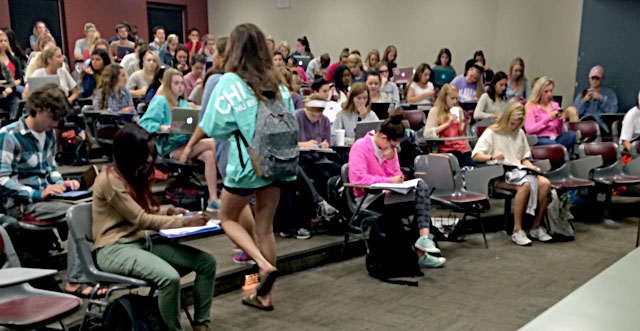Bart Elmore, an assistant professor in the history department, teaches both smaller, discussion-based courses as well as 240-person history surveys. He has to approach participation differently based on class size. For the smaller courses, there are two levels of participation, with the first being simply physical.
“It’s important to hold students accountable to show up,” Elmore said. “Having a sign-in sheet where students are required to sign in – and you don’t do it at the very beginning so that people are actually there – I just think is almost a necessity for a class that size.”
The second, deeper level of participation required for Elmore’s smaller courses is mental presence. Elmore requires students to send discussion questions to him before class in order to further gauge participation. These questions also provide a way for quieter students to show their understanding of material without necessarily speaking up in class.
“There are quiet students, and then there are louder students, so it’s really great to know that this person’s being quieter but they get it, and I don’t need to necessarily prod them to the point where they feel uncomfortable,” he said.
Offering other ways to show participation and understanding is a source of relief for some students. Shelby Shaw, a junior majoring in communication studies, said different learning styles need to be considered when professors design courses.
“Some students, myself included, don’t learn that way, and especially in courses where I am not as comfortable, I get more anxiety thinking about having to answer questions out loud, thus taking away from learning the material,” she said. “Although each class weighs participation differently, I am way more relaxed when I know there isn’t that extra pressure.”
Monitoring discussion isn’t the only way to measure participation. Brad Tuggle teaches small literature seminars in the Honors College. He measures preparation before class with reading quizzes at the start of each class meeting.
“If you haven’t prepared for class, then you can’t participate well,” Tuggle said.
Although it is not graded, Tuggle said class discussion still drives his seminars and he relies on the participation of his students to further the discussion.
“If there are students who are not participating, then I have to have conversations with those students and ask why, ask if there’s something I can do or we can do as a class to include them,” he said.
He said students who always talk in class can substitute quality of participation for quantity.
“My favorite student is the student who chimes in every once in a while, but when they chime in it’s a really significant comment that shows not only that they have something significant to say but that is relevant and builds upon others in the class, and it furthers the conversation rather than cutting the conversation off,” he said.
Lonnie Strickland teaches Strategic Management, the final required course in the University’s business school. The course uses cases where students take on the role of businesspeople and make decisions in real life simulations, basing those decisions on their previous course work.
“Participation is important because it results in great practice in thinking fast and being able to defend your position,” Strickland said. “It is as close as we can get to the world of business.”
Having the ability to participate in a meaningful discussion has applications to life after academia. Jessica Shaw, an alumna who is a first year law student at Savannah Law, said she sees the benefits of practicing discussions inside the classroom.
“So many students have lost sight of really having passion about learning in a collaborative academic community, and that needs to change,” Shaw said. “Our academic lives, and our real lives for that matter, aren’t lived inside a vacuum and our classroom environment should mimic that.”









